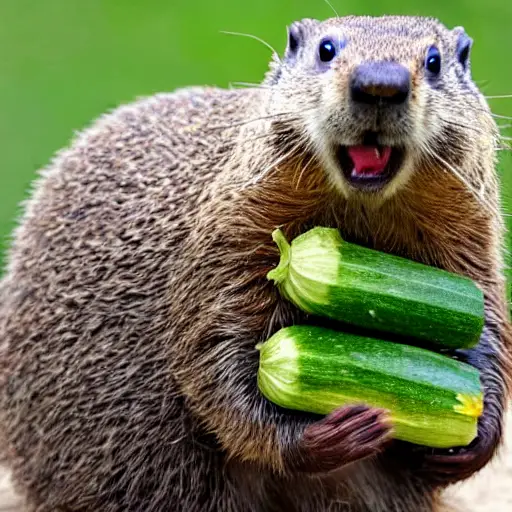Groundhogs, also known as woodchucks, are one of the most common pests in North America. They can be found in many different environments, including forests, fields, and even urban areas.
Groundhogs are mostly herbivores, meaning that they eat mostly plants including tomatoes, onions, and other vegetables and flowers in your garden – and yes, this also includes zucchinis!
In this blog post, I will also get into how to keep groundhogs away from your vegetable garden.
Do Groundhogs Eat Zucchini?
Zucchini is a type of squash that is often grown in gardens. They enjoy the taste, water content, and texture of squash-type vegetables, and will eat them if given the opportunity.

If you have Zucchini plants in your garden, there is a good chance that groundhogs will eat them.
Do groundhogs eat zucchini leaves and zucchini plants?
Yes, groundhogs eat zucchini leaves and zucchini plants. They will even eat small zucchini that are still hard and unripe. It is important to keep an eye on your garden and pick any ripe fruits off the zucchini plants so you don’t attract groundhogs with the smell of food.
Do groundhogs eat butternut squash?
Groundhogs eat butternut squash. They will even dig up the whole plant to get at the squash. This is why many people hang old CDs around the base of their plants, as they reflect light and make it hard for groundhogs to see and the sudden flashes of light scare them away.

There are also actual machines that deter animals by flashing lights when they come close.
If you find a groundhog eating your butternut squash, it is best to scare them off right away. Groundhogs can carry rabies and other diseases that you do not want to be exposed to.
What other animals could have eaten my squash or zucchini plants?
Other animals that may have eaten your zucchini and squash plants include raccoons, rabbits, skunks, armadillos, and porcupines. You can also check for mole tunnels in the garden as these animals may be using them to get closer to the plants.
9 ways to protect your zucchini plants from groundhogs and other wild animals!
If you believe an animal has been rooting in your garden where there were previously healthy plants but now are missing their leaves – take a look at these tips for protecting them from groundhogs!
They include:
1. Motion-activated sprinklers
Like most animals, groundhogs hate surprises, and they will run away if suddenly sprayed with water. I like this solution because it is humane, simple, effective, and does not require much time to set up.
The Havahart 5277 is a motion-activated sprinkler that is activated by the movement of animals up to 25 feet away and sprays them with a harmless water jet, frightening them off and keeping them at bay. The included metal stake makes it easy to install in your garden, and the sprinkler can be rotated 180 degrees for maximum coverage.
2. Ultrasonic sound emitters
Groundhogs, like other bigger animals that may invade your garden, tend to have very good hearing. This means that loud or consistent noises will scare them away or at least shorten their visits.
One of my favorite technologies to keep pests away from my backyard is these cool solar-powered ultrasonic sound emitters that you can buy right off Amazon! In my experience, they really work, and the solar panels on top save you the time and money of changing batteries all the time.
3. Interplanting With Repellent Crops
This involves planting your zucchini and squash among companion plants such as cucumbers, ginger, lettuce, and eggplants. The strong aroma of these crops often discourages groundhogs from approaching the more vulnerable zucchini and squash plants. This is a great way to protect your garden against groundhogs. Also, it is a great way to save space and produce a good harvest even if you have limited space in your garden.
4. Fencing Around The seedbed
Fence, with poultry wire or electric fencing, around the bed where you will be planting your zucchini and butternut squash. This will prevent groundhogs from getting into the bed and eating the seeds as they germinate. Make sure that groundhogs can’t burrow under the fence either. You should make sure that the fence is at least a foot deep and extend it at least a few inches below the soil level to prevent groundhogs from digging under it.
5. Using Hot Pepper Or Garlic Spray
This is a good way to protect your zucchini and butternut squash plants against pests such as rabbits, deer, and groundhogs. It will also protect your garden against the neighbor’s dog that thinks it is fine to use your zucchini and squash bed as a toilet. You only need about 1 tablespoon of crushed pepper/garlic per gallon of water. Spray this mixture on any exposed parts of the plant until completely covered. Make sure you reapply whenever rain washes away the spray.
6. Using Artificial Repellent
You can use some of the commercially available repellents to protect your zucchini and butternut squash plants against groundhogs. You will need to be careful when using these though because some of them can end up harming you and your pets if not applied properly. Some of the commercial groundhog repellents available include Shake-Away, Hound Dog, Critter Ridder, and Fencing Aid.
7. Hanging CDs Around The Base Of Your Plant
This may be a little old-fashioned but it still works. The reflective surface of a CD drives groundhogs crazy and will make them look away from your plants. You can even use old CDs you no longer need, but make sure there are no scratches or dirt on them. If you have a lot of plants to protect this way, it may be a good idea to invest in some commercial CD scarers.
8. Using a Scarecrow
Scarecrows may look a little funny in your garden, but they work surprisingly well. Just make sure your scarecrow is big and scary enough to deter groundhogs from getting anywhere near your zucchini and butternut squash plants. Also, you need to replace the scarecrow every now and then as groundhogs will get used to it.
9. Using Mothballs
Mothballs are another type of commercial repellent that works well to protect your zucchini and butternut squash plants against groundhogs. You just need to scatter a few mothballs around the base of the plant every now and then, depending on how big your garden is.
Just be careful where you scatter the mothballs because the smell of them can actually get to you. This is, however, not our favorite technique as it is less effective and risk spreading toxins in your garden.
10. Using live traps
Using live traps to catch the groundhog and drive it away to somewhere safe, but far away, is perhaps the best option if you want to get completely rid of groundhogs in your yard!
You can make a trap yourself with some wire and ingenuity…
But, you can also just buy a live trap, as the sturdy metal ones shown here:
Put in some bait (a zucchini?!) and you are ready to catch some groundhogs!








